The Plot Folds: An Interview with Margarita Gluzberg
Margarita Gluzberg's fascination with the fictions that sustain capitalism seems increasingly relevant as they start to unravel in the face of the financial crisis. Here the artist talks to Peter Carty about her recent show The Money Plot
Margarita Gluzberg is an artist based in London. This summer her exhibition, The Money Plot, was on show at the Paradise Row gallery, Bethnal Green, in London's East End. It consisted of paintings and an installation of a large archival construction called The Reading Room based on a 1930s trade fair stand. The images feature everyday objects and situations: for example, a fist (Kulak), the bottom half of a couple seated at a table (The Divorce Lawyer), a plate of langoustines (Coming With Her Husband). They are often surreally rendered, always with an exacting technical precision. Most of the paintings were arranged in a ‘salon hang', grouped closely together, with the majority on one wall of the gallery, in the fashion of 19th century art shows. This idiosyncratic presentation reflected the way in which the show brought historical references and preoccupations back into the present. Moreover, the approach was reinforced by the fact that Paradise Row itself is not a mainstream gallery; it occupies part of St Matthews church hall in Bethnal Green, and is a rather traditional looking space, a world away from the white cubes that dominate so much of the contemporary art world.
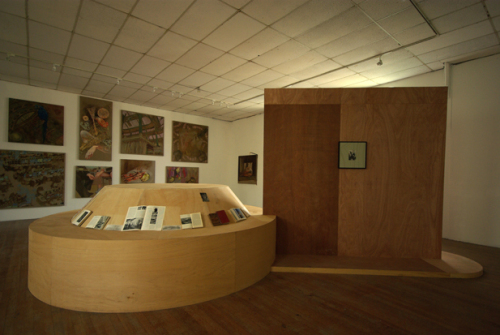 Image: Margarita Gluzberg, installation view of The Money Plot
Image: Margarita Gluzberg, installation view of The Money Plot
PC: What made you call the show The Money Plot? I gather you were interested in parallels between the financial issues that arose in post-Napoleonic France, as fictionalised in Balzac and Flaubert, and our own current problems with capital and credit.
MG: At the end of Balzac's Cousin Bette there is an appendix called ‘The Money Plot’, inserted at the insistence of Balzac's publishers, to explain and untangle the complex web of financial interrelationships in the novel. It's a really strange text that reduces everything in the novel to finance. There is an element of fiction present in any financial transaction (and vice versa). I am interested in the fictions of consumer desire, the ways we can project fictions and fantasies using capital. I was interested in Madame Bovary, Flaubert's novel from the same period, which also deals with the way a life can be fictionalised through money and credit. Even up to the last moment before her downfall, Mme Bovary is still busy shopping and satisfying her consumer desires – she's a kind of ultimate consumer. And this idea of credit – of financial transactions as fantasy that becomes an operative mode, it actually becomes something that is a driver within society, a motor by which reality is configured – this is very much true of today.
PC: There's a concept of yours called ‘The Mesh’ that recurs in your work, isn't there?
MG: It's my analogy for a self-organising process of desiring – sorry, but I have to refer to the notion of a Deleuzian desiring machine here, about the way one thing generates another throughout a system. The painting Blackout depicts the UBS trading floor: a mesh of bodies and computers and financial workings. I have turned the people and their productive unit into a pattern; there's a kind of 1940s comic strip feel about it. The people and their unit of production become meshed together by a series of lines. So as an image it's a mesh, and as a social construct it's a mesh.
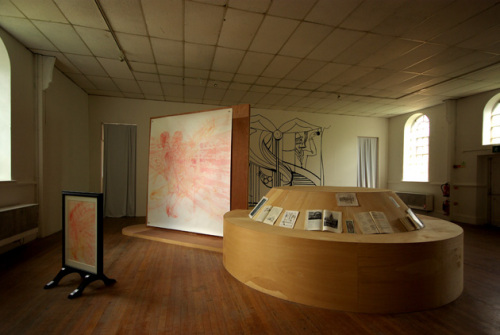 Image: The Money Plot, installation view
Image: The Money Plot, installation view
PC: The notion of the mesh bleeds over in material way into the actual paintings and installations doesn't it?
MG: The mesh is not just about images, but also materials. I'm very interested in pinstripes and pinstripe suits, and I use herringbone linen backings to my paintings. It has quite a traditional weave, but it looks like suit material. So there's an idea of cloth being produced by the industrial revolution and then being made into suits for the people dealing with capital to wear in the stock exchange. I'm interested in the material backing of the painting being the support of the city and its machinations. So one object is not representing another, but is the thing it represents. The object and the image then become meshed in the most obvious sense (laughs).
PC: There's a focus on Russia and the old Soviet Union in your work, isn't there?
MG: The painting Pravda is partly autobiographical: I lived in Russia until 1979, so I joined the Soviet Union as child. In mid-1990s Pravda folded (although not permanently; it was later relaunched as a completely different kind of tabloid). In the painting I make use of the old typeface in a collage and I've put it together with a painting of Prada shoes, a recent window display.
It's about the new ‘truth’ of capitalism that reinserted itself into the fallen Soviet Union – Prada becomes the new truth. It's a rather obvious joke on one level, although the mayor of Moscow in the early 1990s, Yuri Luzhkov (a Guiliani kind of figure), when agreeing to let in the new desirable fashion labels still insisted they used the cyrillic alphabet on their store signs. So you used to see Prada, but written in Russian script, in cyrillic script. And the new truth is as pervasive as the old truth. London is full of the Russian new truth – Russians are the main consumers of luxury goods here.
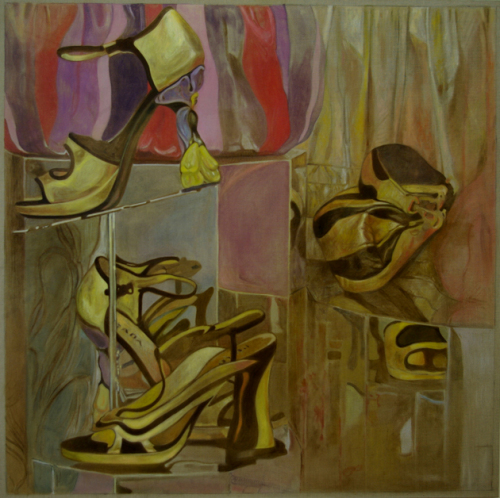 Image: Margarita Gluzberg, Pravda
Image: Margarita Gluzberg, Pravda
PC: So some of the works in the show narrativise your own insertion into the mesh.
MG: I like the way that certain personal things creep into a more general narrative. Although I'm not producing a general treatise, I'm producing a kind of mesh of events that took place. The Divorce Lawyer is all about a set of financial transactions concerning the state, money and sex. It looks at an illicit transaction relating to my divorce, which took place in a high level divorce establishment. I don't want to go into details in case I get anyone into trouble, but certain interactions took place under the table. It was a very fundamental kind of transaction. When I got divorced I got my body back from the state: you have to pay the state to get married; you have to pay the state to get divorced. I don't want to sound cynical – because I am not cynical about this – but relationships revolve around money. To go back to literature again, I've been reading the Brontes recently and in the most seemingly romantic novels there's a lot at stake financially: sex and romance cannot escape the monetary space within which they operate. And in this work I've produced a narrativised strand of all that; it's about trying to depict the body within these material and financial flows.
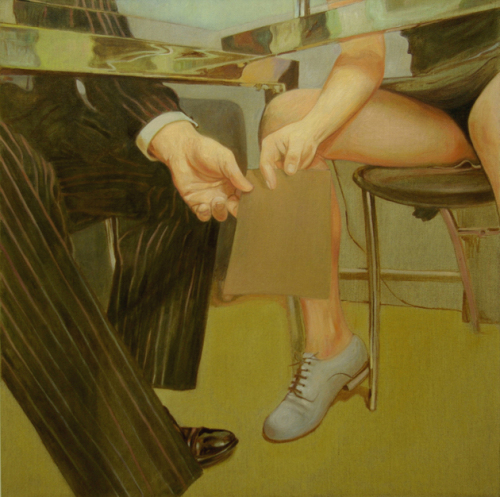 Image: Margarita Gluzberg, The Divorce Lawyer
Image: Margarita Gluzberg, The Divorce Lawyer
PC: The installation The Reading Room with its emphasis on shopping evokes Benjamin and his Arcades project, doesn't it?
MG: I tend to come to texts, literary or philosophical, by accident. Again, it tends to be this mesh that I operate in, so that as I started making this work it became obvious that I should look at Benjamin. The arcade is very much symbolic of the dream of consumption. I have been spending time in the North of England and I have become fascinated by the grandeur of the Industrial Revolution. The arcades of the North are very reminiscent of Benjamin's writings about Paris and the 19th century arcades there. The Leeds market has these amazing cast iron spaces: Benjamin talks about cast iron as the new material of the industrial revolution, the way it became a kind of mass-produced grandeur. In the 19th and 20th centuries there were all these palaces of commerce that were erected, and I'm very interested in the utopian dream that collapsed with the collapse of all that industry. Leeds is full of shopping arcades; in fact it's now reinvented itself as a shopping city. It's become part of the global shopping village, complete with chains like Gap.
The market is very interesting as this symbolic space of basic exchange, which the arcades enhance and help to make shopping into an elevated state of being. I'm very interested in the mysticism of consumption. I like the word ‘consumystic’ – the production of fiction as almost a state of trance. Mme Bovary is an example of a consumer in almost a perfect state of religious trance, in which her shopping becomes a cult of consumption – and that's what modern consumer culture relies upon, a kind of trance of consumption. Once you've bought into it, like any cult, you can't leave because your parameters become different; the outside doesn't exist.
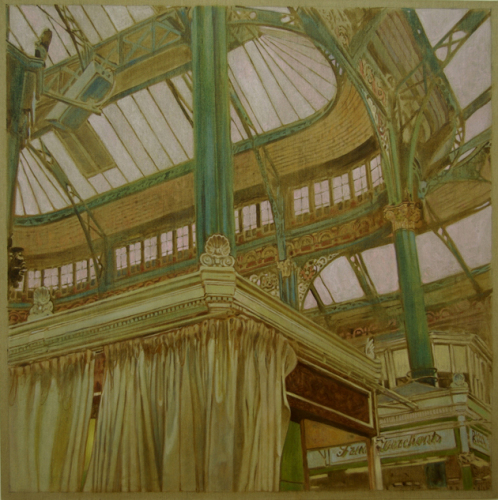 Image: Margarita Gluzberg, Leeds Market
Image: Margarita Gluzberg, Leeds Market
PC: But of course that cult has run into problems lately.
MG: Yes I'm interested in the idea of a fiction collapsing, of the collapse of a cult, and this is the confusion we are seeing. There's a sense of a fiction being torn apart and of what to do next. We constantly invent fictions and you need a fiction to survive – I'm interested in depression, both economic depression and the personal depression that goes with it. And personal or economic depression is when a dominating fiction bursts. Everyone gets depressed, the country gets depressed, when that ridiculous fiction cannot be sustained.
PC: So you're interested in the mesh, and the way it has no outside. And you're interested in the way it all collapses?
MG: (Laughs.) Yes. But remember that an art show itself already supports a fiction of the art market. Painting on canvas creates a very symbolic object. It exists within a history of objects as an art commodity. So I'm looking through this art market at other markets and realities. But it's not a critique, it's more of a personalised critical commentary; although I couldn't have tackled it without certain critical theories being known to me (they inform my work, but I don't necessarily subscribe to them – I'm not really a communist). I've used them plus my autobiographical experiences and physiological experiences to negotiate a certain aspect of contemporary existence.
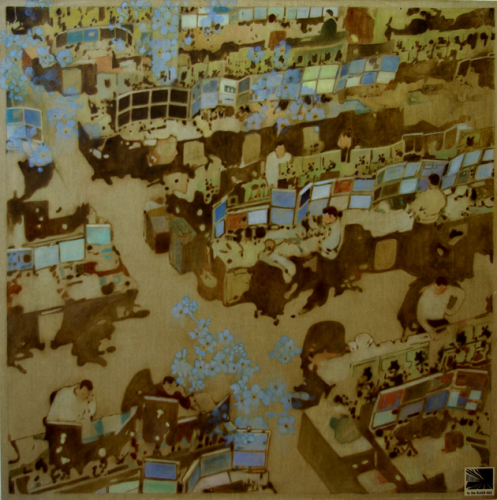 Image: Margarita Gluzberg, In The Blackout
Image: Margarita Gluzberg, In The Blackout
PC: How has your upbringing in the Soviet Union influenced all of this?
MG: I left Russia in 1979 at the height of the Brezhnev era. My father left earlier and sent me some consumer objects back from the West. But I had a Soviet childhood until I was ten or eleven. I distinctly remember this desire for objects, and a lack of them – it's not that I was completely obsessed by jeans but I certainly was, to some degree, lusting after objects.
So there was very little available but I had the same desiring after objects as someone in the West. I remain very interested in the physiological human desire for things. My early childhood was spent in a utopian society full of totalitarian architecture that represented so much and shockingly has crumbled or been obliterated or turned into shopping malls, and of course I see analogies and parallels with this collapse and the situation of consumer capitalism now.
PC: And the boho left-wing lifestyle affected by affluent bourgeois people in and around the art world, what do you make of all that with your background?
MG: Anti-consumerism is just another form of consumerism. Consumption is so complex now, and that's reflected in my show. In a minor way.
Info
The Money Plot was on show at Paradise Row from 2 May - 8 Jun 2008: http://www.paradiserow.com/exhibitions/_15/
Mute Books Orders
For Mute Books distribution contact Anagram Books
contact@anagrambooks.com
For online purchases visit anagrambooks.com






